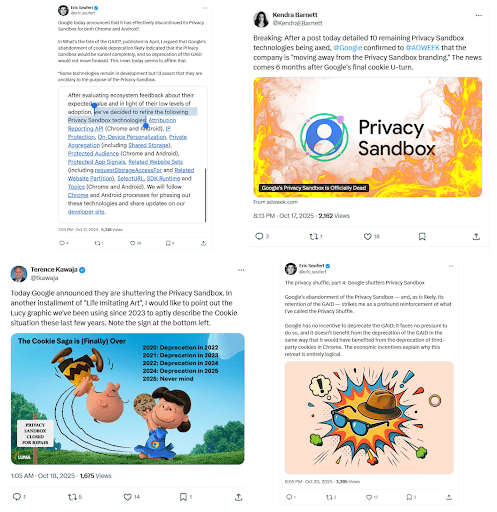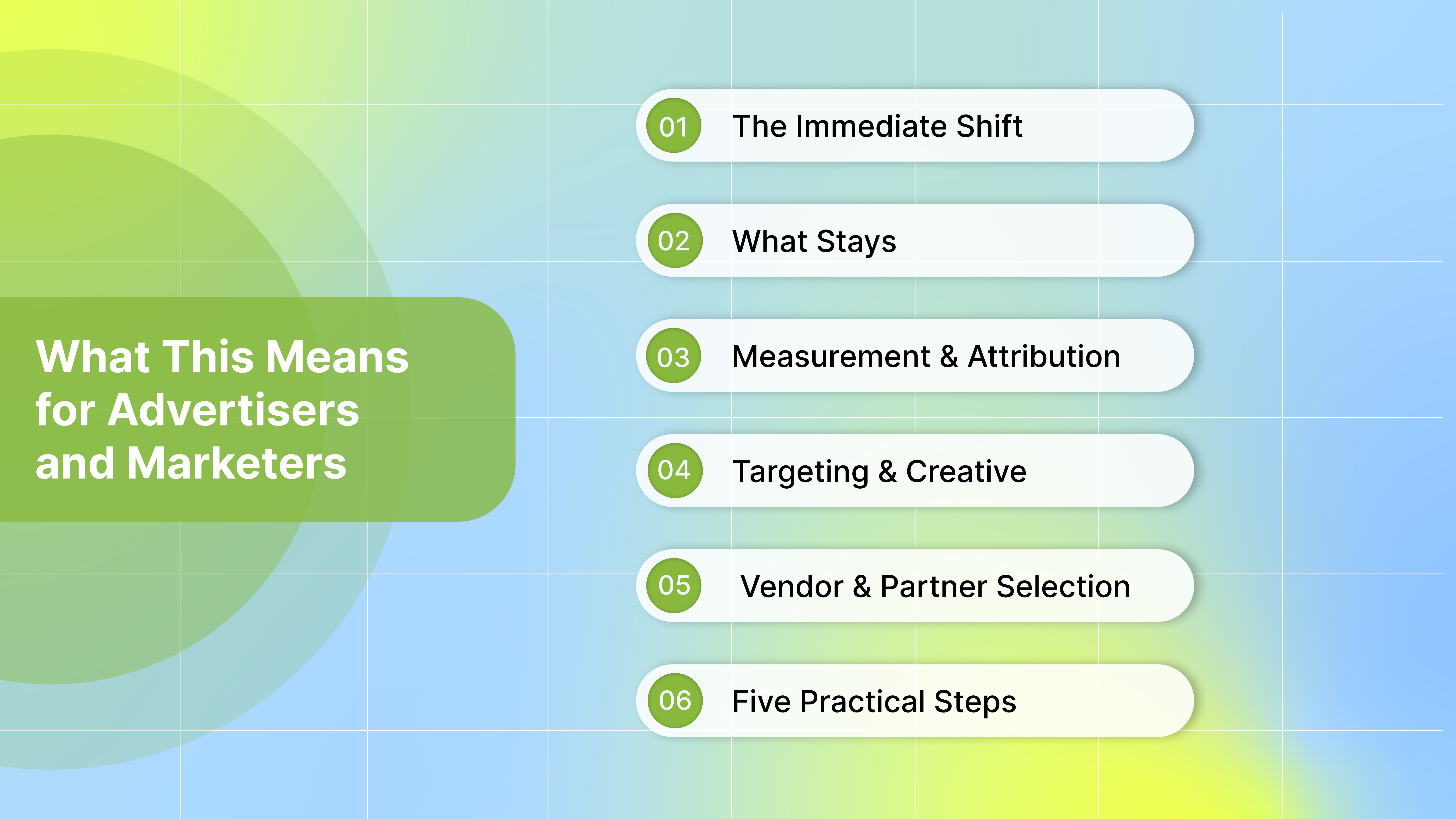Google Privacy Sandbox Update 2025: Why Google Shut It Down
You need clear, repeatable measurement and steady ad performance, but recent platform changes have made both harder to achieve. The Google privacy sandbox update on October 17, 2025, says Google will retire many Privacy Sandbox technologies after getting low adoption and ecosystem feedback.
This follows Google’s April 22, 2025, decision to drop a planned cookie prompt and keep the current cookie controls, a change that already shifted how tracking and tests would roll out.
Industry coverage calls the project ended and warns teams to avoid assuming a single new standard will replace current tools. At the same time, Google’s status pages show that a few platform features will remain supported while many APIs are being phased out.
In this blog, we'll explain what Google changed, why the company pulled back, how this affects measurement and creative testing, and provide clear next steps you can use right away.
What is Google Privacy Sandbox?
Google began building the Privacy Sandbox in 2019 as a set of new web and mobile tools to let websites and apps measure and show ads without using the old third-party cookie method. The idea was to give browsers a way to protect people’s privacy while still letting businesses understand ad performance and reach audiences.
Over time, Google released several APIs and features under that program, including Topics, Protected Audience, Attribution Reporting, and CHIPS (Cookies Having Independent Partitioned State), and made some of them available in Chrome and Android for testing.
Why Google Privacy Sandbox Mattered

The initiative aimed to reshape how digital ads are measured and targeted. Here’s what mattered most:
Ad tech needs and slow adoption: Many companies tested the new APIs, but adoption of several key features remained low. Google said low uptake of certain APIs was a primary reason for retiring them. For you, that meant those tools never reached the scale needed to rely on them for stable measurement.
Regulatory pressure: Authorities in the U.S., U.K., and EU questioned how Sandbox changes might affect competition. In 2025, U.S. courts ruled that Google had maintained monopoly power in parts of its ad business, while U.K. regulators revisited Google’s earlier privacy commitments. This scrutiny shifted Google’s priorities and created uncertainty across the industry.
Industry concerns about accuracy and control: Many in the ad ecosystem worried that replacing direct identifiers with browser-level APIs could reduce precision and give browser vendors greater control. That created resistance from parts of the market that need reliable attribution and creative testing at scale.
Because Google paused or retired large parts of the plan, the immediate result is that many teams keep relying on existing measurement tools for now. That makes short-term planning more stable, while the longer-term path to privacy-first standards is still open.
Key Events Leading to the Shutdown
Before understanding why the Google privacy sandbox update took a different direction, it helps to look at how things unfolded step by step. Each stage shaped the final outcome:
2019 (Project launched): Google introduced the Privacy Sandbox idea and started proposing browser and mobile APIs as alternatives to cross-site tracking.
2020–2022 (Design and proposals): Google published multiple APIs and ran tests with Topics, Protected Audience, Attribution Reporting, and others while the industry and regulators gave feedback.
2023–2024 (Delays and debate): Progress slowed as privacy groups, ad tech vendors, and competition authorities raised technical and competition concerns. Google repeatedly pushed back timelines.
April 22, 2025 (Major U-turn on a cookie prompt): Google announced it would not add a separate prompt to phase out third-party cookies and would leave cookie controls inside Chrome’s existing settings, an apparent change of course.
Mid-2025 (Regulatory moves and reviews): Regulators (including the UK’s CMA) reviewed earlier commitments and the wider competition risks tied to these changes. That scrutiny narrowed Google’s options and added legal pressure.
October 17, 2025 (Formal retirement announcement): Google published an update saying it would retire a large set of Privacy Sandbox technologies and focus on a smaller set of features and standards work instead.
This timeline shows how technical tests, industry feedback, and regulatory action stacked up, pushing Google to stop the broader Privacy Sandbox rollout rather than keep evolving it.
Main Reasons Behind the Shutdown

Now that the key events are clear, the next step is understanding why Google decided to wind down a project that aimed to reshape digital advertising. Here are the core factors:
1. Low Adoption of the New APIs
Many of the Privacy Sandbox APIs never gained enough real-world use. Google cited limited uptake as a major reason for retiring parts of the project. In short: if the tools aren’t widely used, they can’t replace the systems teams already depend on.
2. Heavy Regulatory and Legal Pressure
Regulators in the U.S., U.K., and EU probed whether changes would hurt competition in ad tech. That scrutiny led to formal reviews and, in some places, the release of past commitments because the context changed, adding legal risk to pushing the plan forward.
3. A Public Shift Back to Preserving Cookies for Now
When Google said it would not introduce a standalone prompt to remove third-party cookies, it signaled a practical retreat. That move made the original Privacy Sandbox purpose replacing cookies much less urgent, reducing momentum for the full program.
4. Industry Concern About Measurement and Control
Many in the ad ecosystem worried that the new, browser-level APIs would reduce precision, change how attribution works, and concentrate control in browser platforms. Those concerns slowed buy-in from vendors and publishers who needed stable, accurate measurement.
5. Technical Complexity and Slow Rollout
Building privacy-preserving, scalable substitutes for cross-site identifiers proved more complex and slower than expected. Multiple design iterations and long test phases kept adoption low and stretched the project timeline.
6. Business and Strategic Tradeoffs
Maintaining existing cookie behavior provided short-term stability for large parts of the ad ecosystem. At the same time, Google faced tradeoffs between pursuing a risky system change and avoiding further regulatory or market disruption. That calculus made winding down more attractive.
Taken together, these points explain why the project’s direction changed: progress was slower than needed, adoption remained low, and the regulatory environment weighed on every decision.
Responses across the ad tech industry provide a clear picture of how the update landed.
Also Read: Creative Analytics Explained: How To Track, Measure, And Improve Ad Performance
How the Industry is Reacting
Major industry voices posted that Google has effectively discontinued the Privacy Sandbox for Chrome and Android. These posts highlight that several Sandbox technologies were retired and that the change follows slow adoption and regulatory pressure.
Image advise

This has left teams unsure about the timing and tools for measurement. This change affects day-to-day planning. Here’s how it shows up in practical work.
What This Means for Advertisers and Marketers

Google announced it is retiring many Privacy Sandbox APIs and will phase out those technologies for Chrome and Android. At the same time, Google said it will continue to support a small set of platform features.
1. The Immediate Shift You Should Expect
Google’s notice says several Sandbox APIs with low adoption are being retired, while others that improve login flows and reduce cross-site tracking will remain. This means the promised one-stop replacement for third-party cookies is not arriving from Google in the form previously planned. As a result, measurement and targeting will look different across channels and vendors.
2. What Stays (And Why It Matters to You)
Google confirmed it will continue to support a few platform features focused on privacy, security, and fraud reduction:
CHIPS (Cookies Having Independent Partitioned State), FedCM (Federated Credential Management), and Private State Tokens. These help with cookie partitioning, privacy-friendly sign-ins, and verifying legitimate traffic, but they do not restore audience-level targeting or full attribution.
Keep them in mind for security and user flows, not as replacements for measurements.
3. Measurement and Attribution
Expect more fragmentation in reporting. Some channels will keep older cookie paths, others will use aggregated or modeled approaches, and a few will push server-to-server measurement. Don’t wait for one standard build event collection; you own and run controlled tests so you can measure lift even when partner views differ. Reporting differences and regulatory scrutiny are major reasons Google made this change.
4. Targeting and Creative (What Keeps Working)
Identifier-based buys will be less predictable. Creative that aligns with context and user intent will perform better in uncertain targeting setups. Run fast, creative tests tied to placement and content so you can find high-performing messaging without depending on fragile ID matches. This reduces risk if browsers or platforms change rules again.
5. Vendor and Partner Selection (What to Ask for Now)
Vendors will pivot from promised sandbox integrations to server-side, SDK, and first-party solutions. Ask partners for recent case studies that show measurable lift without the retired APIs. Also, ask how they handle data privacy, what fallback modes they support, and how they will behave if rules change again. Treat live proof as a requirement, not an optional extra.
6. Five Practical Steps You Can Take This Week
Confirm which consented first-party signals you can collect and store reliably.
Stand up or expand server-side event capture so you retain raw events for modeling and lift tests.
Run contextual creative A/B tests in parallel with any ID buys to compare outcomes quickly.
Require short, timed vendor demos that show performance without sandbox APIs; ask for test data.
Update contract language to require transparency and a fallback plan if a measurement method is later limited.
Treat this update as a prompt to strengthen the parts of your stack you control. Focus on first-party data, resilient measurement, and creative that converts without perfect identifiers. Those moves will keep performance steady while the wider market figures out the next standard.
Also Read: Understanding Mobile App Attribution
Conclusion
On October 17, 2025, the update retired a large set of Privacy Sandbox APIs and ended Google’s push for a single, Chrome-led replacement for third-party cookies. This move leaves measurement and targeting fragmented across legacy identifier paths, modeled or aggregated signals, and server-side solutions.
Marketers should therefore secure the signals they control today: collect consented first-party events, route critical events to server endpoints for reliable modeling, and run quick creative A/B tests that demonstrate lift without relying on fragile identifiers.
Segwise’splatform is designed to help teams navigate this exact shift by moving from unstable identifier-based tracking to creative and event-level measurement. Its multimodal AIautomatically tags creative elementsacross formats, hooks, CTAs, visuals, on-screen text, audio cues, and playables, and maps those tags to performance metrics such as ROAS, IPM, CTR, and CPA. This allows teams to see which creative choices drive results.
Segwise connects to ad networks and MMPs via no-code integrations, centralizing creative and measurement data, including server- and partner-level events for consistent, tag-level analysis across channels.
It also offers a rolling Free Meta Ad Library tracker with a 7-day competitor dashboard that highlights new competitor creatives within hours. This is especially useful when targeting signals weaken and creative testing becomes more important.
Start a Free Trial to access creative-level insights that help you maintain performance while the industry determines the next steps.
FAQs
1. What was the Google privacy sandbox update on October 17, 2025?
Google announced it would retire many Privacy Sandbox APIs and shift to supporting a much smaller set of platform features and standards work.
2. Why did Google decide to retire most Sandbox technologies?
Google pointed to low adoption by the ecosystem, plus legal and regulatory pressure and technical limits that made a full replacement for cookies impractical.
3. Which Sandbox features are being kept, and which were dropped?
Google said it will keep a few platform components (such as CHIPS, FedCM, and Private State Tokens) while retiring APIs such as Topics, Protected Audience, and several attribution tools.
4. What immediate effect does this update have on ad measurement and targeting?
Expect more fragmentation: teams will keep relying on existing cookie-based paths, server-side capture, and modeled or aggregated measurement instead of a single browser-led replacement.
5. What practical moves should advertisers and analytics teams make now?
Prioritize first-party signals, expand server-side event collection, run contextual creative tests, and require vendors to show live proof and fallback methods for measurement.
